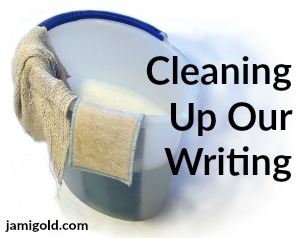I’ve mentioned before that I write very “clean,” and that helps me when it comes time to getting my stories professionally edited. Julie Glover, my copy editor, gives me a “clean” discount, which saves me money. (Always a good thing. *smile*)
Part of why I write clean is because I’m a slow writer and detail-oriented. Neither of those are traits others can necessarily emulate—or would want to—but there are other ways we can strengthen our skills if we’d like to write cleaner.
The second answer to how I write clean is that I’ve learned what I tend to get wrong. Then I watch out for those issues when drafting and doing my earlier editing passes. And that technique is something we all can do.
While I’m having another surgery this week, my copy editor extraordinaire, Julie Glover, is filling in for me with her advice on the most common copy editing issues she sees. With her help, we might all be able to write more cleanly. *smile*
Please welcome Julie Glover!
*****
4 Common Issues You Can Fix
Before Your Copy Editor Does
by Julie Glover
As Jami has pointed out, it’s worthwhile having a copy editor take a look at your manuscript. Poor grammar can interrupt the flow of your story, and no matter how good you are with language and grammar, we all make mistakes.
4 Common Issues You Can Fix Before Your Copy Editor Does by @julie_glover Click To TweetBut you know what? Some mistakes I see in manuscripts are easily fixed by the author, if they know what to look for. Since no copy editor is above missing something themselves, and some copy editors offer discounts for clean manuscripts, it makes sense for you to correct what you can.
Let’s talk about four common issues I see in manuscripts and how you can quickly edit them yourself.
#1: Repetitive Words
When you write the novel, you probably don’t notice the repetitive words. But when I’m copy editing, I notice if you use totally three times on a page.
Look, we all have our favorite words. When I first started writing, everything was just this and just that. It’s like I’d married the word just and dragged it around as my own ball-and-chain.
Figure out your favorite words and then, before turning your manuscript over, run a search for them. Find out if you might have used quite 324 times in a 350-page novel. (Oops!) Then hatchet-job many of those.
Beyond favorite words, sentence openings are highly prone to repetition. While I understand that we often start dialogue with So in regular conversation, it can get overused quickly on the page.
Other repetitive sentence openings include And and But. Run capital-sensitive searches (e.g., So, not so) and eliminate the unnecessary uses.
#2: Commas before Too, Either, and Also
If you’re as old as I am, you remember your middle school or high school English teacher instructing you that the word too at the end of a phrase or sentence required a comma before: “I went to the store, too.”
But language and grammar evolve. That comma is now considered superfluous by most grammarians. The sentence is hardly unclear without the comma: “I went to the store too.”
In fact, the only time you need a comma with the word too (and even this is somewhat subjective) is when you want to make a contrast that requires a pause, like: “I, too, went to the store.” Either and also have the same rule.
Should you eliminate all those commas before too, either, and also? Actually, it depends on what you write.
In a historical novel I recently copy edited, I left the commas because they fit the time period and style of prose. But in a contemporary novel, I suggest removing them.
You simply don’t need them anymore. Moreover, they take up space and make the reader pause, when what you want is for the reader to keep moving forward.
#3: Proper Punctuation for Dialogue and Action Tags
Punctuation around dialogue is one of the most confusing grammar issues I see. Let’s break down how to punctuate dialogue and action tags.
Let’s say you have basic dialogue and a tag. In this case, you simply need a comma:
“You never listen to me,” she said.
“I’d listen if you said something worth listening to,” he yelled back.
“Well,” the counselor said, “it seems we have a lot of work to do.”
If you use other punctuation within the dialogue, you might not even need the comma:
“You never listen to me!” she said.
“Do you ever say something worth listening to?” he asked.
“Well,” the counselor said, “it seems we have a lot of work to do.”
But what about when you don’t have the basic he said/she said construction? What if you’re showing us what a character is doing, or how she’s speaking, or what feeling he’s expressing? While that lets us know who’s talking, it’s an action tag and a separate thought altogether. Just treat those as separate sentences.
“You never listen to me.” Her voice lowered to a whisper.
“I’d listen if you said something worth listening to.” He gritted his teeth in barely restrained anger.
The counselor tapped his pen on the clipboard on his lap. “It seems we have a lot of work to do.”
But what happens when you interrupt dialogue with an action?
Many authors, once again, attempt to treat these sentences like speech tags, using mere commas to separate them. I often see something like: “Well,” the counselor tapped his pen on the clipboard in his lap, “it seems we have a lot of work to do.”
It’s a reasonable guess, but also incorrect punctuation. Let me show you what that interruption should look like:
“You never”—her voice lowered to a strained whisper with the word never—”listen to me.”
“I’d listen”— he gritted his teeth in barely restrained anger —”if you said something worth listening to.”
“Well”—the counselor tapped his pen on the clipboard in his lap—”it seems we have a lot of work to do.”
Why do you use em dashes? Because that action bit is an aside. It’s like a Shakespearean actor interrupting what’s happening long enough to clue the audience into subtext.
So here’s the format in a nutshell: “Dialogue”—action—“dialogue.” That’s it. Pretty simple once you know it.
#4: Single Spaces between Sentences
While the standard was once putting two spaces between sentences, the advent of scalable font made that second space unnecessary. Rather, your sentences should have a single space between them.
Most authors already know this, but sometimes we tap that space bar twice now and then—whether by habit or accident. These oopses also occur in between words, not just sentences.
I catch most of them while I read. But it’s easier to run a search for double spaces in the manuscripts I copy edit. You can do the same.
Using your Replace function, type in two spaces in the Find box and one space in the Replace box and hit Replace All. Before you know it, you’ll see a message like 52 Replacements Made.
In addition to these common mistakes, you might come up with your own checklist of grammar issues to hunt down before turning over your manuscript to an editor. Maybe you need to check your uses of ellipses or spelling of proper names or how many times your characters shrugged. As you learn your own quirks, you can develop a unique approach to keep your prose correct, fresh, and eminently readable.
*****
 Julie Glover writes young adult fiction, collects boots, practices rampant sarcasm, and advocates for the interrobang. Her YA contemporary novel, SHARING HUNTER, finaled in the 2015 RWA® Golden Heart®.
Julie Glover writes young adult fiction, collects boots, practices rampant sarcasm, and advocates for the interrobang. Her YA contemporary novel, SHARING HUNTER, finaled in the 2015 RWA® Golden Heart®.
She copy edits when she can, teaches courses on grammar and young adult fiction, and is represented by Louise Fury of The Bent Agency.
Find Julie online at her website and on Twitter.
*****
Thank you, Julie! This is great advice, and I often point out these same issues in the first few pages on manuscripts I’m doing a developmental edit on, just to give the author a heads up on what to watch out for before working with their copy editor. So I agree with your take on how common these issues are.
I want everyone to pay special attention to Julie’s tip about interrupting dialogue with action in #3. That’s a punctuation rule I rarely see addressed in blog posts on the topic, and even editors I highly respect don’t always know that one. Maybe in addition to qualifying for a clean discount, you’ll be able to teach your editor a thing or two. *smile*
Do you consider yourself (or have you been told you are) a clean writer? If so, what traits or habits help you write clean? How much do you try to clean up your manuscript before turning it over to others? Have you noticed any of these issues in your work or in the work of others? What habits do you need to watch out for in your writing?

